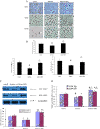Erythropoietin attenuates cardiac dysfunction by increasing myocardial angiogenesis and inhibiting interstitial fibrosis in diabetic rats
- PMID: 22954171
- PMCID: PMC3527329
- DOI: 10.1186/1475-2840-11-105
Erythropoietin attenuates cardiac dysfunction by increasing myocardial angiogenesis and inhibiting interstitial fibrosis in diabetic rats
Abstract
Background: Recent studies revealed that erythropoietin (EPO) has tissue-protective effects in the heart by increasing vascular endothelial growth factor (VEGF) expression and attenuating myocardial fibrosis in ischemia models. In this study, we investigated the effect of EPO on ventricular remodeling and blood vessel growth in diabetic rats.
Methods: Male SD rats were randomly divided into 3 groups: control rats, streptozotocin (STZ)-induced diabetic rats, and diabetic rats treated with 1000 U/kg EPO by subcutaneous injection once per week. Twelve weeks later, echocardiography was conducted, and blood samples were collected for counting of peripheral blood endothelial progenitor cells (EPCs). Myocardial tissues were collected, quantitative real-time PCR (RT-PCR) was used to detect the mRNA expression of VEGF and EPO-receptor (EPOR), and Western blotting was used to detect the protein expression of VEGF and EPOR. VEGF, EPOR, transforming growth factor beta (TGF-β), and CD31 levels in the myocardium were determined by immunohistochemistry. To detect cardiac hypertrophy, immunohistochemistry of collagen type I, collagen type III, and Picrosirius Red staining were performed, and cardiomyocyte cross-sectional area was measured.
Results: After 12 weeks STZ injection, blood glucose increased significantly and remained consistently elevated. EPO treatment significantly improved cardiac contractility and reduced diastolic dysfunction. Rats receiving the EPO injection showed a significant increase in circulating EPCs (27.85 ± 3.43%, P < 0.01) compared with diabetic untreated animals. EPO injection significantly increased capillary density as well as EPOR and VEGF expression in left ventricular myocardial tissue from diabetic rats. Moreover, EPO inhibited interstitial collagen deposition and reduced TGF-β expression.
Conclusions: Treatment with EPO protects cardiac tissue in diabetic animals by increasing VEGF and EPOR expression levels, leading to improved revascularization and the inhibition of cardiac fibrosis.
Figures



Similar articles
-
Vascular endothelial growth factor is crucial for erythropoietin-induced improvement of cardiac function in heart failure.Cardiovasc Res. 2010 Jul 1;87(1):30-9. doi: 10.1093/cvr/cvq041. Epub 2010 Feb 5. Cardiovasc Res. 2010. PMID: 20139114
-
Cardiac fibrosis and dysfunction in experimental diabetic cardiomyopathy are ameliorated by alpha-lipoic acid.Cardiovasc Diabetol. 2012 Jun 19;11:73. doi: 10.1186/1475-2840-11-73. Cardiovasc Diabetol. 2012. PMID: 22713251 Free PMC article.
-
Intravitreal injection of erythropoietin protects both retinal vascular and neuronal cells in early diabetes.Invest Ophthalmol Vis Sci. 2008 Feb;49(2):732-42. doi: 10.1167/iovs.07-0721. Invest Ophthalmol Vis Sci. 2008. PMID: 18235022
-
Morphometric and Molecular Interplay in Hypertension-Induced Cardiac Remodeling with an Emphasis on the Potential Therapeutic Implications.Int J Mol Sci. 2025 Apr 24;26(9):4022. doi: 10.3390/ijms26094022. Int J Mol Sci. 2025. PMID: 40362262 Free PMC article. Review.
-
Survival and proliferative roles of erythropoietin beyond the erythroid lineage.Expert Rev Mol Med. 2008 Dec 1;10:e36. doi: 10.1017/S1462399408000860. Expert Rev Mol Med. 2008. PMID: 19040789 Free PMC article. Review.
Cited by
-
TT-1, an analog of melittin, triggers apoptosis in human thyroid cancer TT cells via regulating caspase, Bcl-2 and Bax.Oncol Lett. 2018 Jan;15(1):1271-1278. doi: 10.3892/ol.2017.7366. Epub 2017 Nov 8. Oncol Lett. 2018. PMID: 29387245 Free PMC article.
-
High glucose induces Smad activation via the transcriptional coregulator p300 and contributes to cardiac fibrosis and hypertrophy.Cardiovasc Diabetol. 2014 May 5;13:89. doi: 10.1186/1475-2840-13-89. Cardiovasc Diabetol. 2014. PMID: 24886336 Free PMC article.
-
Insights from the use of erythropoietin in experimental Chagas disease.Int J Parasitol Drugs Drug Resist. 2022 Aug;19:65-80. doi: 10.1016/j.ijpddr.2022.05.005. Epub 2022 Jun 17. Int J Parasitol Drugs Drug Resist. 2022. PMID: 35772309 Free PMC article.
-
Regulation of TLR4 expression mediates the attenuating effect of erythropoietin on inflammation and myocardial fibrosis in rat heart.Int J Mol Med. 2018 Sep;42(3):1436-1444. doi: 10.3892/ijmm.2018.3707. Epub 2018 May 25. Int J Mol Med. 2018. PMID: 29845292 Free PMC article.
-
Murine Models of Heart Failure with Preserved Ejection Fraction: a "Fishing Expedition".JACC Basic Transl Sci. 2017 Dec;2(6):770-789. doi: 10.1016/j.jacbts.2017.07.013. Epub 2017 Dec 25. JACC Basic Transl Sci. 2017. PMID: 29333506 Free PMC article.
References
-
- Cooper ME, Vranes D, Youssef S, Stacker SA, Cox AJ, Rizkalla B, Casley DJ, Bach LA, Kelly DJ, Gilbert RE. Increased renal expression of vascular endothelial growth factor (VEGF) and its receptor VEGFR-2 in experimental diabetes. Diabetes. 1999;48(11):2229–2239. doi: 10.2337/diabetes.48.11.2229. - DOI - PubMed
-
- Yoon YS, Uchida S, Masuo O, Cejna M, Park JS, Gwon HC, Kirchmair R, Bahlman F, Walter D, Curry C. et al.Progressive attenuation of myocardial vascular endothelial growth factor expression is a seminal event in diabetic cardiomyopathy: restoration of microvascular homeostasis and recovery of cardiac function in diabetic cardiomyopathy after replenishment of local vascular endothelial growth factor. Circulation. 2005;111(16):2073–2085. doi: 10.1161/01.CIR.0000162472.52990.36. - DOI - PubMed
Publication types
MeSH terms
Substances
LinkOut - more resources
Full Text Sources
Research Materials

